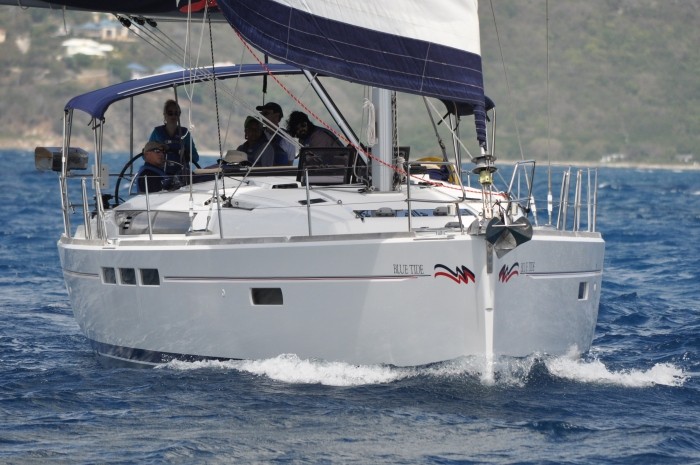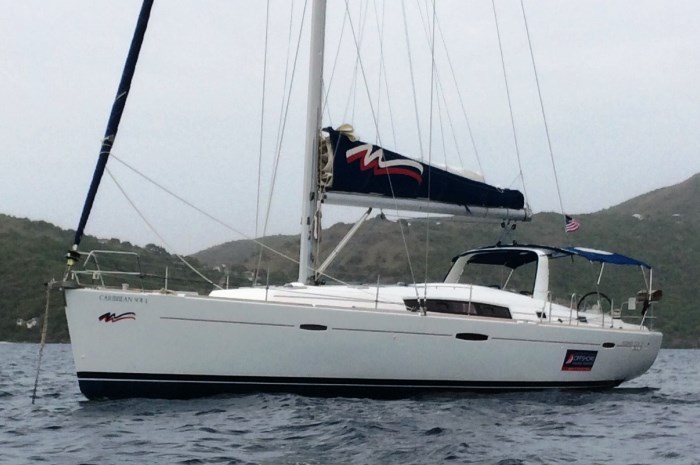Convenience, ease of operation and safety make roller-furling headsails popular with cruising sailors.
Most cruising sailboats use roller-furling headsails. In this roller furling system, the jib is hoisted in a groove, but when not in use is furled around the headstay, rather than lowered. To furl the sail you simply pull on a line that leads from a drum at the base of the jib aft to a winch near the cockpit, which rotates the whole headstay, rolling up the jib.
If you want to reduce sail area just roll it up halfway. The end result is not perfect  because the middle of the stay lags behind the ends in rolling, and the middle of the sail becomes very full. Also, the clew rises higher in the air the more the jib is rolled up. This is fine when reaching in heavy air because there is less chance to scoop water. But it puts the center of effort high off the water and increases heeling. The jib sheet leads will have to be moved to accommodate the new angle made by the jib sheet when the jib is half rolled.
because the middle of the stay lags behind the ends in rolling, and the middle of the sail becomes very full. Also, the clew rises higher in the air the more the jib is rolled up. This is fine when reaching in heavy air because there is less chance to scoop water. But it puts the center of effort high off the water and increases heeling. The jib sheet leads will have to be moved to accommodate the new angle made by the jib sheet when the jib is half rolled.
Understanding Furling Systems
The sail, when rolled up, is still exposed to sunlight and subject to UV deterioration. So sailmakers add a panel of UV-resistant material along the leech. This panel is on the outside of the rolls as the jib is rolled up and protects the rest of the furled sail.
When using a roller-furling system, you generally sail on a reach to unroll the jib. This allows the sail to unroll without flailing against the mast and shrouds. As mentioned before, it’s best to control the line from a winch rather than let it fly. If you don’t use a winch, when the jib is about half unrolled in a fresh breeze you won’t be able to hold that line, and if you just let it fly, the line can become tangled in a turning block or twist and become jammed around the furling drum, making it very difficult to rewind.
To furl the jib, it’s necessary to luff it completely. Free the sheet and head the boat up to reduce speed and heel angle, but don’t flog the sail against the shrouds. This hurts the sail and increases friction, making the sail more difficult to furl.
If the genoa furling line is hard to pull, do not put it on a winch. First check that the genoa halyard is really tight. To furl well, the luff of the job needs to be stretched taut, or the furling mechanism won’t work well. Excessive headstay sag creates the same problem. Obviously, turning a rod that’s curved takes more force than turning a straight one. Extra backstay tension may help. If there’s still resistance, check that the upper furling fitting turns freely. Sometimes another halyard gets wound up in it. Winching can break something. If everything seems clear, but it’s still hard to pull the furling line, head downwind and blanket the jib behind the main. Only after you’ve exhausted other options should you use the winch to furl the genoa. If the jib won’t furl at all, something must be broken and the headsail should be lowered to the deck.
After the sail is completely rolled up, roll a couple of extra turns for good measure. Wrapping the jib sheets around the outside of the sail locks the furl in place. There’s less chance for the wind to catch some of the sail and unfurl it. For more information, see our Sailing Basics page.
Happy Sailing from Steve Colgate, founder of Offshore Sailing School!
Reprinted from “Steve Colgate on Sailing” by Steve Colgate; published by W.W. Norton & Co.








